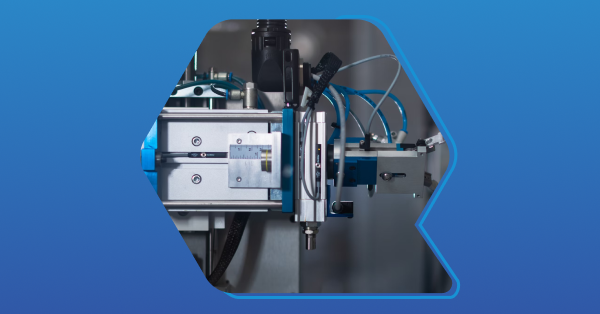LIMS Evaluation Criteria and Checklist: Make the Right Choice For Your Lab

Your lab finally has budget approval for a LIMS. It’s a six-figure line item in some cases, and the switching costs are brutal, so you can’t afford to make the wrong choice.
You need certainty. Or at least as much certainty as a rigorous evaluation process can provide.
In this guide, you’ll find a set of criteria for evaluating a LIMS to determine whether or not a vendor is right for your lab. We’ve based this on hundreds of LIMS implementations over the years across various industries, and hope this guide gives you the tools to pick a LIMS that won’t fail your lab.
The Most Common Types of LIMS
Before we get to the specific criteria, let’s review three of the most common types of LIMS you will encounter:
- On-premises
- Cloud-based
- Custom-built
On-premises
On-premises LIMS are installed and operated on the laboratory's local servers, providing full control over data. While on-prem LIMS offer complete control, they require significant upfront investment in hardware, IT infrastructure, and security. Maintenance and updates can be time-consuming and costly as well.
Managing backups, generating audit trails, and patching data at a moment's notice will be needed if you aim to meet rigorous testing standards, like ISO 17025 or HIPAA.
Cloud-Based
Most software these days is cloud-based, meaning the software is hosted on remote servers and accessed via the internet.
A cloud-based LIMS provides remote access for staff, allowing anyone, anywhere, to access your LIMS. With security features, access controls, and regular data backups, your data is safe (and the burden of managing security does not fall on you). Many cloud-based LIMS offer a monthly subscription and multiple feature packages, allowing you to adjust as your needs change. Some vendors will gate features behind higher tiers (like SSO or API access), so it’s important to note what you are really getting access to with your subscription.
Custom-Built
Custom-built LIMS are developed from the ground up to meet your lab’s unique requirements.
While you could build virtually anything, you’ll also own every bug, every late-night fix, and every compliance headache. Building comparable functionality could take significantly longer and cost far more than implementing an existing solution. Plus, your lab will be responsible for ongoing maintenance, updates, and maintaining data quality and backups. This requires dedicated IT resources, including hiring competent developers to make changes.
On-premises vs Cloud: Which Architecture is Best?
Before moving on, it’s worth stressing the key trade-offs between on-premises and cloud-based LIMS:
- Infrastructure: On-premises software requires your lab to manage servers, security, and software updates. Cloud-based LIMS shifts that responsibility to the vendor.
- Accessibility: Cloud-based LIMS enable secure access from anywhere with an internet connection, while on-prem LIMS limit access to the lab's network. While this may give you more control on-site, it makes things complicated for a distributed team.
- Scalability: Cloud-based LIMS can scale up or down based on your lab's needs. Scaling an on-premises LIMS requires additional hardware and IT resources. Not to mention adapting the software to your changing needs and feature requests.
- Added fees: Cloud-based LIMS have lower upfront costs and operate on a subscription model. On-prem LIMS have higher initial costs for hardware and installation. Ongoing maintenance and updates can significantly increase long-term costs.
This isn’t just theoretical, though. Here’s a real-life example from a lab we spoke with that encountered numerous roadblocks with their on-premises LIMS, outdated hardware, and rigid software platforms.
Every time they wanted to make a change, the staff had to go through one engineer, who was nearing retirement and not always available to make changes or willing to do so.
The result? Brittle software and frequent outages led to disconnected tracking systems across Excel and physical notebooks, further hindering efficiency and flexibility. The continuous mess of data led to low morale, wasted time, and mounting frustration for those who remained with the lab.
LIMS Evaluation Framework: Key Criteria to Follow
To thoroughly evaluate a LIMS, we recommend working through the following framework to assess each vendor’s capabilities against your needs:
- Architecture
- API and integration capabilities
- Data management
- Security and compliance
- Configurability and automation
- Implementation philosophy and approach
- Reliability and support
LIMS Evaluation: Architecture
When selecting a LIMS, prioritize how well the system scales, integrates, and adapts over time. This includes considering the added benefits of cloud-based software, like lower maintenance costs, regular updates, and accessibility for your team. Remember, on-premises solutions may give you complete control, but they also require significant IT resources. From experience, while this may seem an attractive route, it often leads to higher costs in the long run.
Architecture also covers other key considerations, like the underlying database technology and your ability to run large or complex queries, user roles that you can assign, and disaster recovery measures in the event of an outage.
Questions to ask
Beyond the basics of on-prem vs cloud, we recommend asking the following to review your vendor’s architecture:
- If the system were to go down, can you restore a backup yourself, or are you reliant on the vendor? What do you do if this happens on an off-hour, such as a weekend or holiday?
- How does performance scale? If you 10x your data, will performance handle it gracefully or grind to a halt?
- Can lab staff pull reports without the help of a developer? Or do even the simplest queries require technical assistance?
- When your vendor pushes an update that breaks your workflow, can you roll it back, or are you stuck?
- As a follow-up to the above, ask how updates are communicated to customers.
- Should you need to switch your LIMS, can you export your data?
LIMS Evaluation: API and Integration Capabilities
Your lab can’t run on a LIMS that works in isolation — you need to ensure your vendor can integrate with your systems, software, and instruments.
Does your vendor offer an API? Is it RESTful and well-documented? Can it handle real-time data exchange or just batch transfers? We’ve heard horror stories from labs that worked with legacy LIMS systems that claimed to offer an API, but required spinning up a new endpoint for each new client. One lab made a change to their data model and had to wait nine months for that change to be accessible via API, so don’t take API access for granted.
We also recommend looking for pre-built connectors to your existing instruments and software, but don't rely on them entirely; vendors sometimes discontinue support for older integrations.
Questions to ask
Beyond API access, we recommend asking the following:
- How often do your API versions change? For how long do you support outdated versions?
- If an older instrument is no longer a “supported” integration, what do you do?
- If your other systems change their API versions, will this break your LIMS integration?
- Can you build custom integrations, or are you at the mercy of your vendor?
- How fast is the API? Can it support real-time alerts when results go out of spec?
- Do you offer a sandbox for testing?
LIMS Evaluation: Data Management
Data management encompasses more than simple storage. It also covers data integrity, traceability, versioning, and accessibility.
Before selecting a LIMS, it’s important to understand how it handles different data types, automates data capture, backs up records, and audits data for discrepancies. Pay attention to data validation rules and how they're implemented. The LIMS should prevent impossible values and flag outliers, but you need to make sure you are able to configure these rules yourself. As lab compliance shifts from CSV to CSA, it’s helpful to make sure your LIMS can support your efforts in identifying and monitoring higher-risk activities as well.
Questions to ask
Any vendor can say that they “support data management,” but marketing lingo on a web page leaves many questions unanswered, like:
- What happens when impossible values or outliers are recorded?
- When an auditor asks for records over the past two years, can you produce that report quickly?
- If critical data is accidentally deleted, how far back can you restore? How long does data restoration take?
- What accompanying info is tracked with each entry? For instance, user IDs, timestamps, etc.
LIMS Evaluation: Security and Compliance
Labs live and die by their security and compliance measures. One regulatory failure can lead to lost customers, a shutdown from the FDA, or going out of business.
When evaluating a LIMS for security, we recommend starting with user access controls. Can you implement role-based permissions that match your organizational structure? Look for multi-factor authentication, especially for administrative functions. Your vendor should also provide audit trails that meet FDA 21 CFR Part 11, ISO 17025, or other applicable standards for your laboratory. Make sure to look for a LIMS that supports SSO, as necessary as this is, it’s not always a given.
Questions to ask
Security and compliance aren’t marketing buzzwords. Ask questions like:
- Should the FDA conduct a surprise visit, can you demonstrate electronic signature compliance in real-time? Or do you need to prepare reports first?
- If a user leaves your lab, how quickly can you revoke access? Will this break existing workflows?
- If hackers breach your vendor’s cloud, is your data encrypted and safe, or can they easily access it?
- Can you restrict access by time, location, and job function?
LIMS Evaluation: Configurability and Automation
Every vendor claims to be flexible or customizable. But does that mean any user in your lab can log in and edit a report or workflow, or are you stuck waiting for a consultant or developer to make changes?
You need to know what “customizability” truly means and determine the level of technical expertise required to implement even the simplest changes in your LIMS; there is a world of difference between a configurable and a customizable LIMS.
Review the workflow engine, conditional logic, and automated data capture to better understand whether your LIMS truly can save you time or if it will just cost you lots of extra money. Remember that over-customization can create maintenance headaches, so look for platforms that match your workflows naturally while still offering flexibility for unique requirements.
Questions to ask
There is a lot of wiggle room in what “customization” means for a LIMS. Make sure to dig deep with pointed questions to know what you can actually do with your LIMS:
- If test protocols change, can any user update a workflow, or do you need expensive consulting hours and development services?
- If the LIMS promotes “no-code” in their marketing materials, what does that really mean?
- If your QC rules require complex logic, can the LIMS handle it?
- Can you automate report generation and send them to stakeholders? How much human intervention is required to create reports in bulk?
- How far can your team go on your own before needing help from your vendor? What does that help cost?
- Do you offer a sandbox to test workflows before going live?
LIMS Evaluation: Implementation Philosophy and Approach
Your LIMS implementation can make or break your experience.
Look for vendors who invest time in understanding your current processes before proposing solutions. They should offer a structured approach with clear milestones, testing phases, and go-live criteria. Ask about their change management support: do they help train super users and develop adoption strategies? Have they worked with labs like yours? What is their approach to custom development as opposed to in-app configurations?
Be cautious of vendors who promise unrealistically short implementations or appear to have a one-size-fits-all approach.
Questions to ask
Implementation may be just as crucial as the LIMS itself. Ask your vendor the following:
- How long do implementations take? What can derail an implementation?
- If the implementation exceeds the time or budget, who is responsible?
- If unexpected workflow complexities arise, does the LIMS adapt to you, or do you need to adapt entire workflows to it?
- Can you implement it in phases, or must it be done all at once?
LIMS Evaluation: Reliability and Support
A LIMS will fail your lab if it is not a reliable source of truth.
It’s critical to review uptime guarantees, failsafe policies, data center locations, and the quality of support you will get. When disasters occur, vendor reliability determines whether you experience a quick resolution or a stressful all-nighter.
For cloud-based SaaS products, it’s also helpful to ask about your vendor’s product roadmap and SLAs around feature development and bug fixes. Many venture-backed software companies have an impetus to “move fast and break things.” This approach may be suitable for a company aiming to become the next unicorn, but it does not align well with the needs of labs seeking to meet regulatory requirements.
Questions to ask
When you’re in a jam, the quality of your vendor’s support will be the difference in getting out. Ask the following questions:
- If your LIMS crashes during a busy period or a critical test, how long does it take to get back up and running?
- Should your vendor be acquired (it has happened often in this industry; SciSure/eLab is a recent example), will your data be at risk?
- When you call support, are you speaking with an experienced technician or someone reading from a script?
- Can technical issues be escalated to the development team if necessary?
- Where is your support team based? What is your coverage, and what are the protocols for off-hours, such as weekends and holidays?
- Do you publish product status updates or post-mortems in the event of an outage?
Key LIMS Features to Look for
Almost any LIMS will offer features for sample management and inventory management, but beyond that, we recommend paying special attention to vendors that offer the following:
- Configurable: Look for a LIMS that is flexible and configurable to your needs, rather than one that requires extensive development resources and technical help to make the simplest changes.
- Comprehensive reporting and certificates: Look for a LIMS that supports automated generation of certificates of analysis, regulatory reports, and custom documents. We recommend vendors that offer report builders and the ability to include graphs, images, and statistical summaries without requiring technical expertise.
- Self-serve options for customers: A LIMS with a built-in customer portal allows your internal and external clients to submit samples, track project status, and access results without constant phone calls or emails — saving your team hours while creating a stellar experience for your customers.
- Billing and invoice support: For contract labs, integrated billing tools can eliminate the need for manual invoice preparation, reduce the risk of errors, and help your lab get paid faster.
Of all the LIMS on the market, which will you choose?
We can’t decide for your lab, but we can say that at QBench, we’re committed to being a flexible and user-friendly solution for labs looking to scale compliantly.
For us, configurability isn’t a buzzword. It’s one of our product’s guiding principles.
Unlike other LIMS, when we say “flexible” and “configurable,” we mean it, full stop. QBench offers no-code and low-code tools, along with a modern API, to enable your team to customize workflows, generate reports, and make changes on the fly.
Teresa Avila, Geochemist at Koloma Labs, puts it best:
“We went with QBench in the end because it is so editable and can match exactly what we need. We can really get into the guts with QBench and move things around.
That flexibility really helped in making our decision. The fact that it is so configurable meant that we could set it up anyway we wanted it, but going forward, whether requests come from inside the lab or our team out in the field, it’s easy to change things up as we need to.”
Many legacy vendors sell labs on a dream, only to deliver a nightmare; with QBench, you just may have to pinch yourself after seeing what you can configure on your own.
Looking For a LIMS? Download the Free LIMS Buyer’s Guide
A LIMS automates processes, provides a source of truth, and improves data quality to enable your team to make better decisions based on accurate and reliable data. But no two LIMS are the same.
You need to take care to evaluate each vendor, and don’t be afraid to ask these tough questions to get clarity for your team. But a set of questions is just the start of your search; you’ll need a bit more information to select the right LIMS for your lab.
To help you choose the best LIMS for your lab, click the button below to download the free LIMS buyer’s guide. In it, you’ll get an in-depth overview of the different types of LIMS on the market, key features to look for, and more.








